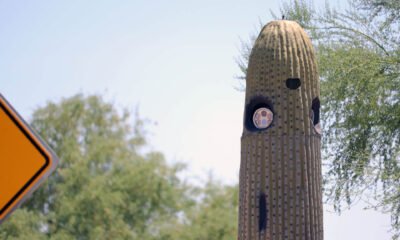animals
Southern Arizona Sees Booming Bobcat Population, New Study Reveals

TUCSON, Ariz. — A recent extensive study reveals a thriving bobcat population in southern Arizona, indicating their successful adaptation to the challenges posed by urban environments. The Bobcats in Tucson Research Project highlights findings from research focusing on the movement and behavior of bobcats in the Tucson area.
By employing radio collars on several captured bobcats, researchers mapped their home ranges, providing valuable insights into their survival and reproductive success. The study noted that bobcat survival rates remained high, with 84% in the second year and 85% in the third year, suggesting these wild cats are not only surviving but also raising multiple litters.
Interestingly, some bobcats have managed to raise their young in urbanized settings, demonstrating a remarkable resilience. The report emphasizes Tucson’s unique ability to coexist with these animals, stating, “Tucson’s relatively seamless coexistence with bobcats is unique and should be a point of pride for the city.” This adaptability sets Tucson apart from many other urban areas, allowing residents a rare opportunity to observe these native creatures in their natural habitat.
Community sentiment towards bobcats appears overwhelmingly positive, with a survey indicating that 90% of respondents welcomed their presence. However, the study also documented challenges, including five instances of bobcats being killed by vehicles and others losing their lives due to human intervention, often during attempts to protect livestock.
The report cautions that one cannot expect bobcats, as specialized carnivores, to distinguish between domestic animals and their natural prey. The implications of these findings reveal a need for increased awareness of wildlife cohabitation and its associated challenges in urban settings.
![Top left: Judge Stephen F. McCarville. Top right: A restraining order on a judge's bench. Background: Maricopa Municipal Court. [Bryan Mordt/City of Maricopa/Pix4free]](https://arizonanews.org/wp-content/uploads/2025/06/City-Faces-Surge-in-Restraining-Orders-Outpacing-Population-Growth-400x240.jpeg)
![Top left: Judge Stephen F. McCarville. Top right: A restraining order on a judge's bench. Background: Maricopa Municipal Court. [Bryan Mordt/City of Maricopa/Pix4free]](https://arizonanews.org/wp-content/uploads/2025/06/City-Faces-Surge-in-Restraining-Orders-Outpacing-Population-Growth-80x80.jpeg)
















